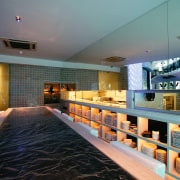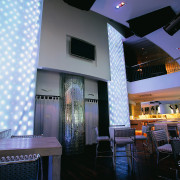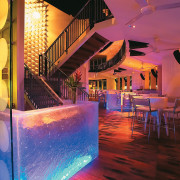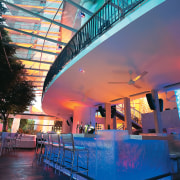Open expression
The new Sevenatenine restaurant and bar in the heart of Kuala Lumpur offers fine dining in quirky, informal surroundings design elements capture the eye at every turn
In any city it's easy to spot the latest hip nightclub the energy of the crowd can be felt from the street. A dynamic crowd and vibrant environment are a venue's best advertisement. But on a constrained urban site, finding the room to create such a space may mean moving beyond traditional ideas of walls and boundaries.
This was the approach taken when architect Ed Poole was asked to create Sevenatenine over the top of an existing dining premises. Opening up to the environment was particularly appropriate here, with the venue sitting on one of the most sought after addresses in the Malaysian capital. Poole explains aspects of the design and some interesting features that have helped Sevenatenine capture the well-heeled public's imagination.
"The client wanted a restaurant and bar with a level of food that approaches fine dining, but without the formality, with a capacity of around 200 seats. Former operations in the space didn't work, possibly because it wasn't big enough to feel happening.
"We started by placing a central island bar on the ground floor. As the plan took shape, there was no way to fit this within the restricted existing glass enclosure, so we removed the building's facade and fully surrounded the property line with a 2.45m high wall of glass," says Poole. "This created a micro-climate on the ground floor, trapping the air conditioning in existing eight-metre tall trees block the hot sun and wind from entering the site."
To further tame the heat of Kuala Lumpur in the opened-up venue, standard solutions like air curtains, ceiling fans and non-drip air vents were employed.
Adding to Sevenatenine's capacity and sense of drama, Poole used the existing building columns to support a new mezzanine that pushed out directly from the building frontage this meant the existing glass facade was removed from the second floor as well. The overall result was a radical alteration to the inner-city building.
"After several weeks of visiting the site, we noticed there was a problem with occasional falling objects, such as a child's toy, from the tower block residences above," says the architect. "We added a giant tempered glass roof over as much of the al fresco and mezzanine area as was structurally practicable, eventually covering about 80% of the site."
This massive glass protrusion provided protection for diners from both falling objects and the rain. It also served as a sound buffer to the venue's music and hubbub for surrounding apartment buildings.
In terms of layout and functionality, the kitchen's position was restricted to being on the ground floor, again partly due to space constraints a tapas style of food service was introduced for casual dining at this level, with more serious private dining catered to on the mezzanine floor overhead.
A separate Private Dining room was created with a fully air conditioned space on the upper level that could also be used as a private dance floor for events. This contains a private bar, tucked behind operable doors.
"Leather wall surfaces and leather chairs in the same tone and texture were chosen for this room, to give the space a cosy, club feel and contrast with the more open and light finishes on the floor below."
On Sevenatenine's interiors, material contrast was an important factor generally. Elements include bleachable white fabric for the sofas, matched with other white elements in fibreglass and polypropylene. The timbers were treated with a lime-wash to introduce a beach-side feel appropriate to the open air setting. The architect used 400-year-old railway sleepers for the flooring, with each sleeper cut in a trapezoid shape to fan around the site. This introduced a subtle Asian quality to the venue.
"As the project was 80% al fresco, we wanted cooling visual effects and so we created a bar that looked like a giant block of melting ice. This is made from crackled resin, with inset blue LED lighting providing a cool contrast to the rich, dark flooring."
In the toilet area, the architect introduced thousands of hand-ground cut glass elements, adding sparkle when the lighting catches them. The overall effect is of a dazzling, eye-catching 1970s disco feature.
The bar and restaurant's open-to-air design allows potential customers to look in, as well as dining patrons to feel part of the close-at-hand city buzz.
"Tall LED panels with sheet covers were introduced partly as an eye catching element that could be seen from the street," says Poole. "As the LEDs can change to any of 16 million colours, the feature has a very strong impact on the mood of the space."
A sense of excitement pervades Sevenatenine's interior and this is partly due to the sheer diversity of elements within the space right down to pampering seating options customised by the architect.
The Accupunto reflexology seating was sourced by Poole at a Jakarta trade fair. These chairs temporarily meld to the shape of their occupants for consummate relaxation. However, Poole customised some aspects to suit the upmarket setting. The original bar stool design, for example, had a low steel frame back but more comfort was added to the back of the chair.
A large white sculptural element on the stairs, a little like a series of connected cones, plays with light and shadow and creates another point of dramatic interest. A similar 3D surfacing is found in black on the toilet doors. Little mirrors were attached for a touch of sparkle.
"Seen from the street, with its glittering LED wall panels, glass overhangs and glass filaments catching the light, Sevenatenine has all the space, coolness and sparkle of an inviting ice cave, found in a desert of heat, movement and urban crush," Poole says.
Story by: Trendsideas
Home kitchen bathroom commercial design











